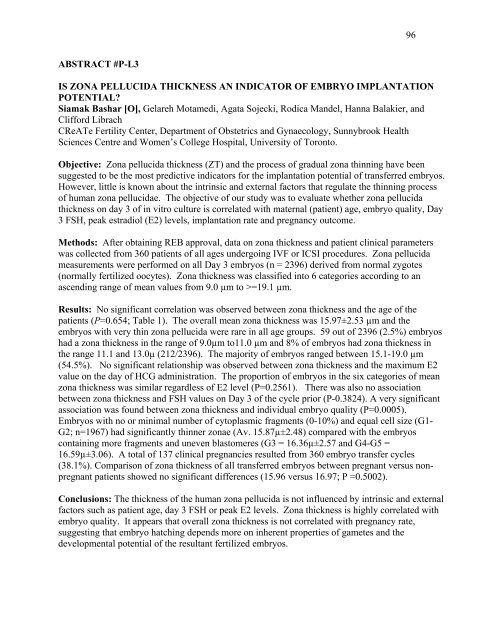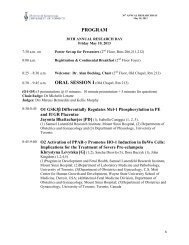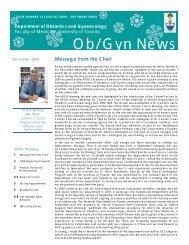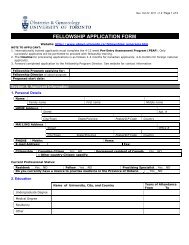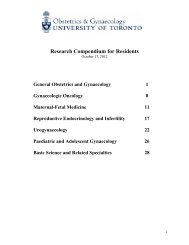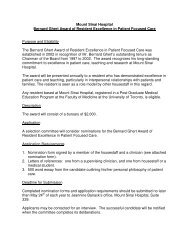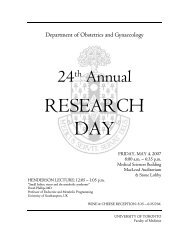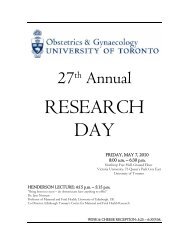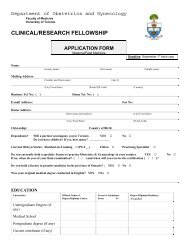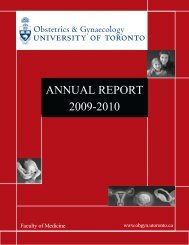research day - University of Toronto Department of Obstetrics and ...
research day - University of Toronto Department of Obstetrics and ...
research day - University of Toronto Department of Obstetrics and ...
Create successful ePaper yourself
Turn your PDF publications into a flip-book with our unique Google optimized e-Paper software.
96<br />
ABSTRACT #P-L3<br />
IS ZONA PELLUCIDA THICKNESS AN INDICATOR OF EMBRYO IMPLANTATION<br />
POTENTIAL<br />
Siamak Bashar [O], Gelareh Motamedi, Agata Sojecki, Rodica M<strong>and</strong>el, Hanna Balakier, <strong>and</strong><br />
Clifford Librach<br />
CReATe Fertility Center, <strong>Department</strong> <strong>of</strong> <strong>Obstetrics</strong> <strong>and</strong> Gynaecology, Sunnybrook Health<br />
Sciences Centre <strong>and</strong> Women’s College Hospital, <strong>University</strong> <strong>of</strong> <strong>Toronto</strong>.<br />
Objective: Zona pellucida thickness (ZT) <strong>and</strong> the process <strong>of</strong> gradual zona thinning have been<br />
suggested to be the most predictive indicators for the implantation potential <strong>of</strong> transferred embryos.<br />
However, little is known about the intrinsic <strong>and</strong> external factors that regulate the thinning process<br />
<strong>of</strong> human zona pellucidae. The objective <strong>of</strong> our study was to evaluate whether zona pellucida<br />
thickness on <strong>day</strong> 3 <strong>of</strong> in vitro culture is correlated with maternal (patient) age, embryo quality, Day<br />
3 FSH, peak estradiol (E2) levels, implantation rate <strong>and</strong> pregnancy outcome.<br />
Methods: After obtaining REB approval, data on zona thickness <strong>and</strong> patient clinical parameters<br />
was collected from 360 patients <strong>of</strong> all ages undergoing IVF or ICSI procedures. Zona pellucida<br />
measurements were performed on all Day 3 embryos (n = 2396) derived from normal zygotes<br />
(normally fertilized oocytes). Zona thickness was classified into 6 categories according to an<br />
ascending range <strong>of</strong> mean values from 9.0 µm to >=19.1 µm.<br />
Results: No significant correlation was observed between zona thickness <strong>and</strong> the age <strong>of</strong> the<br />
patients (P=0.654; Table 1). The overall mean zona thickness was 15.97±2.53 µm <strong>and</strong> the<br />
embryos with very thin zona pellucida were rare in all age groups. 59 out <strong>of</strong> 2396 (2.5%) embryos<br />
had a zona thickness in the range <strong>of</strong> 9.0µm to11.0 µm <strong>and</strong> 8% <strong>of</strong> embryos had zona thickness in<br />
the range 11.1 <strong>and</strong> 13.0µ (212/2396). The majority <strong>of</strong> embryos ranged between 15.1-19.0 µm<br />
(54.5%). No significant relationship was observed between zona thickness <strong>and</strong> the maximum E2<br />
value on the <strong>day</strong> <strong>of</strong> HCG administration. The proportion <strong>of</strong> embryos in the six categories <strong>of</strong> mean<br />
zona thickness was similar regardless <strong>of</strong> E2 level (P=0.2561). There was also no association<br />
between zona thickness <strong>and</strong> FSH values on Day 3 <strong>of</strong> the cycle prior (P-0.3824). A very significant<br />
association was found between zona thickness <strong>and</strong> individual embryo quality (P=0.0005).<br />
Embryos with no or minimal number <strong>of</strong> cytoplasmic fragments (0-10%) <strong>and</strong> equal cell size (G1-<br />
G2; n=1967) had significantly thinner zonae (Av. 15.87µ±2.48) compared with the embryos<br />
containing more fragments <strong>and</strong> uneven blastomeres (G3 = 16.36µ±2.57 <strong>and</strong> G4-G5 =<br />
16.59µ±3.06). A total <strong>of</strong> 137 clinical pregnancies resulted from 360 embryo transfer cycles<br />
(38.1%). Comparison <strong>of</strong> zona thickness <strong>of</strong> all transferred embryos between pregnant versus nonpregnant<br />
patients showed no significant differences (15.96 versus 16.97; P =0.5002).<br />
Conclusions: The thickness <strong>of</strong> the human zona pellucida is not influenced by intrinsic <strong>and</strong> external<br />
factors such as patient age, <strong>day</strong> 3 FSH or peak E2 levels. Zona thickness is highly correlated with<br />
embryo quality. It appears that overall zona thickness is not correlated with pregnancy rate,<br />
suggesting that embryo hatching depends more on inherent properties <strong>of</strong> gametes <strong>and</strong> the<br />
developmental potential <strong>of</strong> the resultant fertilized embryos.


